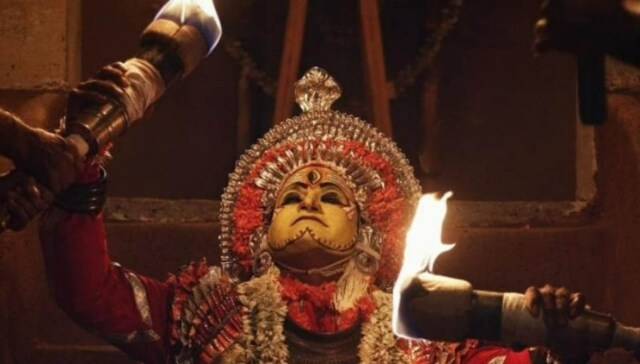In an interview with Film Companion, Rishab Shetty, the writer, director and star of Kantara, spoke at length about the variations and changes in the shrieks of Daiva in the opening and the closing act of the film. “From the opening Kola to the closing Kola, there is a change in the voice and dance – the emotions, intonations and variations”, he said. To an ordinary viewer, especially one who isn’t familiar with the cultural and religious significance of Daiva, the demigod, the shrieks might seem scary – almost terrifying and spine-chilling. The fright is only enhanced when we see a seemingly possessed Kola dancer in full make-up and bloodshot, protruding eyes speaking in a ghost-like heavy voice. Soon, we see the descendant of the King who had lent the land to the tribals, die a painful death as he throws up blood. Throughout the rest of the film, the sudden loud shrieks coupled with jump scares only induce more fear and discomfort – particularly in the non-Mangaloreans and those from the Hindi belt who have probably never witnessed a live Kola performance.
However, in the last 15 minutes of the film, when Daiva reappears and this time, possesses the protagonist of the film, Shiva, one cannot help but be in awe of the spirit that after all these years, continues to watch over and protect the inhabitants of the forest against those attacking their freedom and sovereignty. Soon, the seemingly fearsome spirit that destroyed those who came in its way becomes a guardian and a protector, vanquishing those that dare to question its legitimacy and the rights of the natives it swore to protect. The shrieks which seemed painful and horrifying in the opening Kola, leave the viewers – spellbound and transfixed. When a possessed Shiva walks towards Murali, a man who was his adversary at first but later, an ally and places his hand on his chest – it seemed like the film had come a full circle.
When asked about the significance of Murali’s character, Shetty in his interview to Film Companion had said that he views Murali as someone who represents nature. Murali is deeply concerned about the fast-depleting forest cover and repeated hunting of wild animals by the natives. Shiva, on the other hand, becomes a symbol for ‘man’ in the ‘nature’ vs ‘man’ conflict. Murali and Shiva are at loggerheads with each other throughout the film. The viewers, too, cannot help but ponder over the many ethical and moral dilemmas the film poses. Is it wrong for Shiva to depend on the forest he grew up in for his livelihood and sustenance? Conversely, is Murali wrong for being concerned about the depleting forest cover and lack of biodiversity? The conflict between Murali and Shiva ends when the two join forces to fight Devendra, the evil descendant of the King who owns the land that belongs to Shiva’s tribe. However, it is Daiva who makes Shiva and Murali’s union complete. In Shetty’s words, Daiva ‘acts as a bridge’ between Murali (nature) and Shiva (man) thereby helping them understand each other better and live in harmony without encroaching upon the other’s existence.
After Shiva and Murali’s reunion, Shiva (who is possessed by the spirit), hears the shrieks of Daiva from the adjoining forest. Shiva then runs into the forest with a torch in his hand and meets an identical Kola dancer. The two continue dancing as they disappear forever. Who was the second Kola dancer? Was it Shiva’s brother Guruva who had come back to life? Or was it the Kola dancer who had disappeared into the forest in the opening Kola? Perhaps, it was the image of the many Kola dancers who had previously disappeared into the forest, only to be united with Daiva. That, of course, is open to interpretation,
However, the shrieks which seemed fearsome in the opening act of the film seem soothing and on the contrary, instill a feeling of safety in the viewer. The effect is ethereal and otherworldly. Watching the climax unfold on the big screen is akin to seeing Daiva come alive right before our eyes. The viewer is almost taken aback. What seemed like a film on a hyper-masculine Kambala athlete fighting for his community turned out to be a gripping tale of an ancient folklore coming to life, beautifully so.
In a strange way, when leaving the theatre, I felt as if I took a part of the film with me. More so, it felt as if Daiva himself was watching over me and wouldn’t let any harm come my way. For someone who walked into the theatre knowing next to nothing about Kola, Kambala or the significance of Daiva, Kantara did a commendable job at leaving an everlasting imprint on the viewer’s mind. That, alone, is Kantara’s biggest win.
Kantara is playing now in theatres.
Deepansh Duggal is an entertainment, pop-culture and trends writer based in New Delhi. He specializes in op-eds based on the socio-political and gender issues in the world of entertainment and showbiz. He also writes explainers and occasionally reviews shows in the OTT space. He tweets at @Deepansh75.
Read all the Latest News, Trending News, Cricket News, Bollywood News, India News and Entertainment News here. Follow us on Facebook, Twitter and Instagram.

